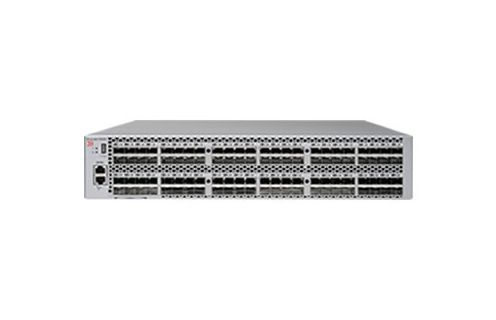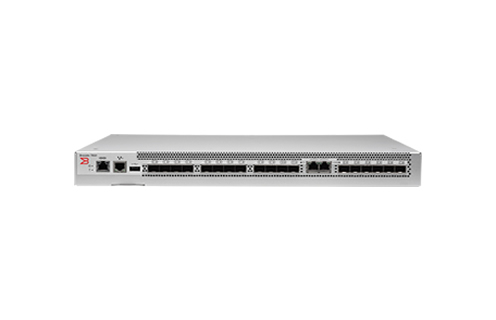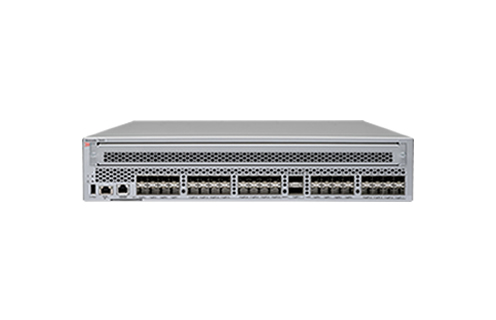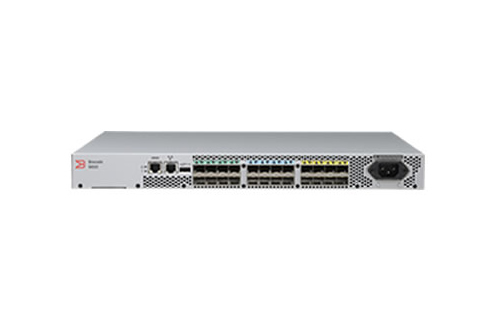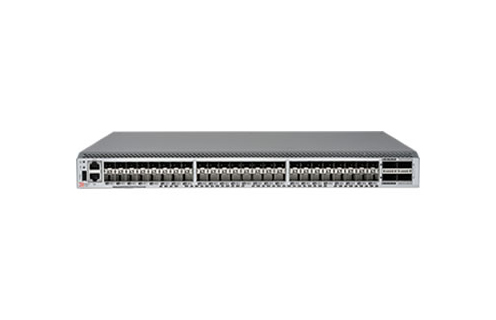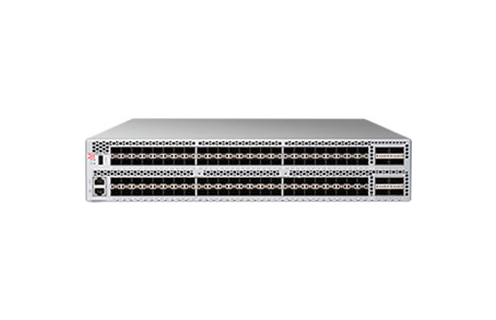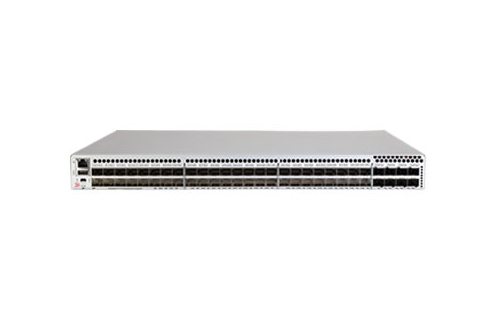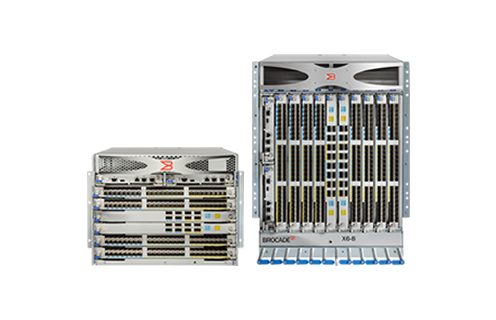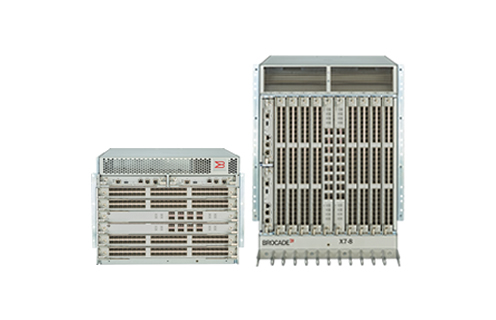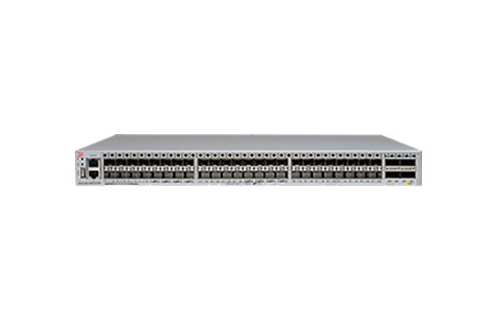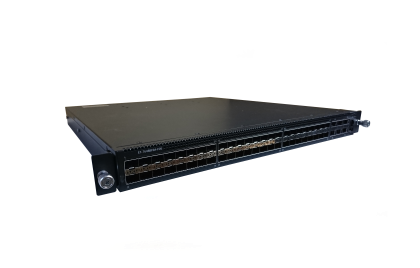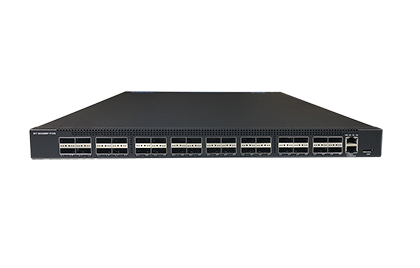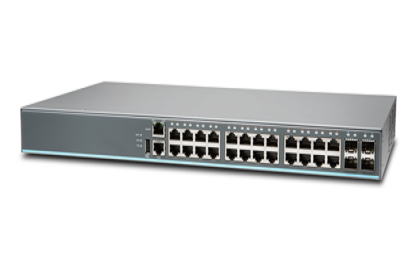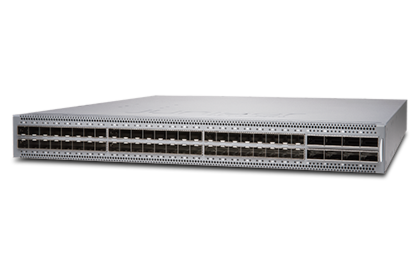For your edge-core-cloud scenarios
Networking solutions

Fujitsu has developed a suite of top-of-rack switches that support flexible and efficient scale-out server infrastructures, especially in combination with new modular servers. This approach results in several improvements, including infrastructure efficiency for cloud computing, end-to-end virtualization and consolidation. Close partnerships with network technology partners complement the portfolio for building complete IT infrastructures. Storage-area networks (SANs) will continue to be the backbone of the data center network for the next investment cycle, but they need enhancements in terms of bandwidth and management functions. To do this, Fujitsu partners with Broadcom, which recently acquired Brocade, the leading provider of SAN switches. And a lot of new use cases are based on Ethernet networks, with bandwidths of up to 100 Gbit and increasingly virtualized fabric architectures for building dynamic data centers. Fujitsu also partners with Extreme Networks, which offers the best of breed, high performance IP Networking Switches. And it goes without saying that Fujitsu server and storage systems are fully compatible with products from all important network switch vendors, including Cisco.
Transform your network with the right switches
Vendor
Product type
Network speed
Number of ports (max.)
Media type
| Brocade 6520 | Brocade 7810 | Brocade 7840 | Brocade G610 | Brocade G620 | Brocade G630 | Brocade G720 | Brocade X6 Directors | Brocade X7 Directors | ExtremeSwitching VDX 6740 | ExtremeSwitching VDX 6940 | FUJITSU PSWITCH 2048 | FUJITSU PSWITCH 4032P | Juniper EX2300 | Juniper QFX5120 | |
|---|---|---|---|---|---|---|---|---|---|---|---|---|---|---|---|
| Fibre Channel ports | Switch mode (default): 48-, 72-, and 96-port configurations (24-port increments through Ports on Demand [PoD] licenses); (E, F, M, D, EX) ports | 12 ports, 32 Gbit/s capable, universal (E, F, M, D, and EX ports) | 24 ports. 16Gbps. universal (E,F,M,D, and EX ports) |
Switch mode (default): 8-, 16-, and 24-port configurations (8-port increment through Ports on Demand [PoD] license); E_Ports, F_Ports, M_Ports, and D_Ports Brocade Access Gateway default port mapping: 40 SFP+ F_Ports, 8 SFP+ N_Ports |
Switch mode (default): Minimum of 24 ports and maximum of 64 ports configuration. Port numbers above minimum are enabled through 12-port SFP+ increments via Ports on Demand (PoD) licenses and through one 4-port QSFP PoD, providing 16-port increments through a Q-Flex license; E_Ports, F_Ports, D_Ports,EX_Ports. Brocade Access Gateway default port mapping: 40 SFP+ F_Ports, 8 SFP+ N_Ports |
96 SFP+ ports capable of operating at 4/8/10/16/32 Gbit/s Fibre Channel auto-sensing speeds; 8 QSFP ports capable of operating at 4×32 / 4×16 / 4×8 / 4×4 Gbit/s Fibre Channel speeds. Offers a base configuration of 48 ports, two 24-port SFP+ PoD (Ports on Demand), and one 32-port QSFP PoD. The switch has a total of eight 32 Gbit/s QSPF ports. This allows users to grow from 48 ports to 128 ports. Supports F/E/EX_Port and D_Port types on the SFP+ ports and only F/E/EX_Port and D_Port types on the QSFP ports with Brocade Fabric OS® (FOS) v8.2.0. |
Switch mode (default): Minimum of 24 ports and maximum of 56 ports. Ports are enabled in increments of 8 ports up to 56 ports via Ports on Demand (PoD) licenses; E_Ports, F_Ports, M_Port, D_Ports, EX_Ports. Brocade Access Gateway default port mapping: 56 SFP+ F_Ports, 8 SFP+ N_Ports.
|
- | - | - | - | - | - | - | - |
| Scalability | Full fabric architecture with a maximum of 239 switches | - | - | Full-fabric architecture with a maximum of 239 switches | Full-fabric architecture with a maximum of 239 switches | Full-fabric architecture with a maximum of 239 switches | Full-fabric architecture with a maximum of 239 switches | Full-fabric architecture with a maximum of 239 switches | Full-fabric architecture of 239 switches. | - | - | - | - | - | - |
| Certified maximum | 6000 active nodes; 56 switches, 19 hops in Brocade Fabric OS® fabrics; larger fabrics certified as required |
Single fabric: 56 domains, 7 hops Multiprotocol routing fabric: 19 hops |
Single fabric: 56 domains, 7 hops Multiprotocol routing fabric: 19 hops |
9,000 active nodes; 56 switches, 19 hops in Brocade Fabric OS® fabrics; larger fabrics certified as required | 6,000 active nodes; 56 switches, 19 hops in Brocade Fabric OS fabrics; larger fabrics certified as required |
Single fabric: 56 domains, 7 hops MPR fabric: 19 hops |
4K active nodes; 56 switches, 19 hops in Brocade Fabric OS® fabrics | 6,000 active devices per switch; 56 switches, 19 hops in Brocade Fabric OS (FOS) fabrics; larger fabrics certified as required | 6000 active devices per switch; 56 switches, 19 hops in Brocade Fabric OS® (FOS) fabrics; larger fabrics certified as required. | - | - | - | - | - | - |
| Performance | Auto-sensing of 2, 4, 8, and 16 Gbps port speeds | - | - | Fibre Channel: 4.25 Gbps line speed, full duplex; 8.5 Gbps line speed, full duplex; 14.025 Gbps line speed, full duplex; auto-sensing of 4 Gbps, 8 Gbps, 16 Gbps, and 32 Gbps port speeds | Fibre Channel: 4.25 Gbps line speed, full duplex; 8.5 Gbps line speed, full duplex; 14.025 Gbps line speed, full duplex; 28.05 Gbps, full duplex; 112.2 Gbps, full duplex; auto-sensing of 4, 8, 16, 32 Gbps port speeds and capable of supporting 128 Gbps speeds | Fibre Channel: 4.25 Gbit/s line speed, full duplex; 8.5 Gbit/s line speed, full duplex; 10.53 Gbit/s line speed, full duplex; 14.025 Gbit/s line speed, full duplex; 28.05 Gbit/s, full duplex; 112.2 Gbit/s, full duplex; auto-sensing of 4/8/10/16/32 Gbit/s port speeds and capable of supporting 128 Gbit/s speeds; 10 Gbit/s optionally programmable to fixed port speed. Auto-sensing of 4×32 / 4×16 / 4×8 / 4×4 Gbit/s speeds on the QSFP ports with Brocade FOS v8.2.0. |
Fibre Channel: 8.5Gb/s line speed, full duplex; 10.53Gb/s line speed, full duplex; 14.025Gb/s line speed, full duplex; 28.05Gb/s line speed, full duplex; 57.8Gb/s line speed, full duplex; auto-sensing of 8, 10, 16, 32, and 64Gb/s port speeds. 10Gb/s [1] optionally programmable to fixed port speed.
|
Fibre Channel:
|
Brocade FC64-48 Port Blade: Fibre Channel: 8.5Gb/s line speed, full duplex; 10.53Gb/s line speed, full duplex; 14.025Gb/s line speed, full duplex; 28.05Gb/s line speed, full duplex; 57.8Gb/s line speed, full duplex. Autosensing of 8, 16, 32, and 64Gb/s port speeds depending on SFPs used. 10Gb/s port speeds with dedicated SFPs. Brocade FC32-X7-48 Port Blade: Fibre Channel: 4.25Gb/s line speed, full duplex; 8.5Gb/s line speed, full duplex; 10.53Gb/s line speed, full duplex; 14.025Gb/s line speed, full duplex; 28.05Gb/s line speed, full duplex. Autosensing of 4, 8, 16, and 32Gb/s port speeds depending on SFPs used. 10Gb/s port speeds with dedicated SFPs.
|
- | - | - |
1280Gbps switching bandwidth (2560Gbps duplex) Automatic address learning function to build the packet-forwarding information table. The table contains up to 96K MAC addresses 12 MB of packet buffer memory Support Jumbo Frame up to 9198 bytes Alternate Store-Forward (ASF) mode - Cut-through is available to minimize the latency Latency x‹ 1 microsecond (64-byte packets) |
- | - |
| ISL trunking | Frame-based trunking with up to eight 16 Gbps ports per ISL trunk; up to 128 Gbps per ISL trunk. Exchange-based load balancing across ISLs with DPS included in Brocade Fabric OS. | - | - |
Frame-based trunking with up to eight 32 Gbps ports per ISL trunk; up to 256 Gbps per ISL trunk Exchange-based load balancing across ISLs with DPS included in Brocade Fabric OS |
Frame-based trunking with up to eight 32 Gbps SFP+ ports per ISL trunk or up to two 128 Gbps QSFP ports per ISL trunk. Exchange-based load balancing across ISLs with DPS included in Brocade Fabric OS. | Frame-based trunking with up to eight 32 Gbit/s connections between a pair of switches combined to form a single logical ISL with a speed of up to 256 Gbit/s (512 Gbit/s full duplex) per ISL trunk. Exchange-based load balancing across ISLs with DPS included in Brocade FOS. On the QSFP ports 256 Gbit/s trunks are supported by trunking 2× (4×32 Gbit/s) QSFP ports. | Frame-based trunking with up to eight SFP+ ports per ISL trunk; up to 512Gb/s per ISL trunk. Exchangebased load balancing across ISLs with Dynamic Path Selection (DPS) included in Brocade Fabric OS. |
Frame-based trunking with up to eight 32 Gbps ports per ISL trunk ; up to 256 Gbps per ISL trunk Exchange-based load balancing across ISLs with DPS included in Brocade FOS |
Frame-based trunking with up to eight 64Gb/s ports per ISL trunk; up to 256Gb/s per ISL trunk; exchange-based load balancing across ISLs with DPS included in Brocade FOS. | - | - | - | - | - | - |
| Aggregate bandwidth | 1536 Gbps end-to-end full duplex | - | - | 768 Gbps end-to-end full duplex | 2 Tbps | 4 Tbit/s | 3.584Tb/s | - | - | - | - | - | - | - | - |
| Fabric latency |
Latency for locally switched ports is 700 ns; latency between port groups is 2.1 μsec, cut-through routing at 16 Gbps between locally switched groups. Encryption/compression is 5.5 μsec per node; Forward Error Correction (FEC) adds 400 ns between E_Ports (enabled by default). |
Non-blocking shared memory, 900 ns with no contention, cut-through switching at 32 Gbit/s | 700 ns with no contention, cut-through routing at 16 Gbps | - | - | - | - | - | - | - | - | - | - | - | - |
| Maximum frame size | 2112 byte payload | - | - | 2,112-byte payload | 2,112-byte payload | 2,112-byte payload | 2112-byte payload | 2,112-byte payload | 2112-byte payload. | - | - | - | - | - | - |
| Frame buffers | 8192 dynamically allocated | - | - | 2,000 dynamically allocated | 15,360 dynamically allocated | 15K frame buffers with dynamic buffer sharing capability across ports | 24K per switching ASIC | 15,000 per switching ASIC | 24,000 per switching ASIC. | - | - | - | - | - | - |
| Classes of service | Class 2, Class 3, Class F (inter-switch frames) | Class 2, Class 3, Class F (inter-switch frames) | Class 2, Class 3, Class F (inter-switch frames) | Class 2, Class 3, Class F (inter-switch frames) | 2,112-byte payload | Class 2, Class 3, Class F (inter-switch frames) | Class 2, Class 3, Class F (inter-switch frames) | Class 2, Class 3, Class F (inter-switch frames) | Class 2, Class 3, Class F (inter-switch frames). | - | - | - | - | - | - |
| Port types | D_Port (Diagnostic Port), E_Port, EX_Port, F_Port, M_Port (Mirror Port); optional port type control | F_Port, E_Port, EX_Port, (FCR E_Port), D_Port (Diagnostic), M_Port (Mirror), and self-discovery based on switch type (U_Port); VE_Port (FCIP and IP extension) | F_Port, E_Port, EX_Port, (FCR E_Port), D_Port (Diagnostic), M_Port (Mirror), and self-discovery based on switch type (U_Port); VE_Port (FCIP and IP) | - | D_Port (ClearLink Diagnostic Port), E_Port, EX_Port, F_Port, AE_Port; optional port-type control Brocade Access Gateway mode: F_Port and NPIV-enabled N_Port | D_Port (ClearLink Diagnostic Port), E_Port, EX_Port, F_Port, AE_Port, optional port-type control |
D_Port (ClearLink® Diagnostic Port), E_Port, EX_Port, F_Port, M port; optional port-type control Brocade Access Gateway mode: F_Port and NPIV-enabled N_Port |
- | - | - | - | - | - | - | - |
| Data traffic types | Fabric switches supporting unicast | Fibre Channel, FCIP, and IP extension | Fabric switches supporting unicast, multicast (255 groups), and broadcast | Fabric switches supporting unicast | Fabric switches supporting unicast | Fabric switches supporting unicast | Fabric switches supporting unicast |
Brocade FC32-48 port blade: Supports hot-pluggable Brocade Fibre Channel SFP+ at 32 Gbps SWL/LWL and SFP+ at 16 Gbps SWL/LWL Core Routing (CR) blades, Brocade CR32-4 and CR32-8: Support hot-pluggable Brocade Fibre Channel QSFP at 4×32 Gbps SWL, 4×16 Gbps SWL QSFP for ICL connections |
Fabric switches supporting unicast, multicast (255 groups), and broadcast | - | - | - | - | - | - |
| Media types | Hot-pluggable, industry-standard Small Form-Factor Pluggable (SFP+), LC connector; Short-Wavelength (SWL), Long-Wavelength (LWL); Extended Long-Wavelength (ELWL); distance depends on fiber optic cable and port speed. Supports SFP+ (2, 4, 8, 16 Gbps) optical transceivers. | - | - |
32 Gbps: Brocade G610 requires Brocade hot-pluggable SFP+, LC connector; 32 Gbps SWL, LWL 16 Gbps: Brocade G610 requires Brocade hot-pluggable SFP+, LC connector; 16 Gbps SWL, LWL, ELWL Fibre Channel distance subject to fiber-optic cable and port speed |
128 Gbps: Brocade G620 requires Brocade hot-pluggable QSFP, MPO connector; 128 Gbps SWL 64 Gbps: Brocade G620 requires Brocade hot-pluggable QSFP, MPO connector; 64 Gbps SWL 32 Gbps: Brocade G620 requires Brocade hot-pluggable SFP+, LC connector; 32 Gbps SWL/LWL 16 Gbps: Brocade G620 requires Brocade hot-pluggable SFP+, LC connector; 16 Gbps SWL/LWL Fibre Channel distance subject to fiber-optic cable and port speed. |
Hot-pluggable, industry-standard Small Form-Factor Pluggable Plus (SFP+), LC connector; Short-Wave Laser (SWL), Long-Wave Laser (LWL); Extended Long-Wave Laser (ELWL); distance depends on fiber optic cable and port speed. Supports SFP+ (32/16/8 Gbit/s), SFP+ (16/8/4 Gbit/s), SFP+ 10 Gbit/s optical transceivers, 4×32 Gbit/s QSFP SWL and 4×16 Gbit/s QSFP SWL optical transceivers. Note: 32 Gbit/s ELWL is currently not supported with Brocade FOS v8.2.0 but is planned for future support. |
64Gb/s: Brocade G720 requires Brocade hot-pluggable SFP+, LC connector; 64Gb/s SWL. 32Gb/s: Brocade G720 requires Brocade hot-pluggable SFP+, LC connector; 32Gb/s SWL, LWL 10 km. 10Gb/s[1]: Brocade G720 requires Brocade hot-pluggable SFP+, LC connector; 10Gb/s SWL, LWL 10 km. Fibre Channel distance is subject to fiber-optic cable and port speed.
|
- |
Brocade FC64-48 port blade: Supports hot-pluggable Brocade Fibre Channel SFP+ at 8/10/16/32Gb/s SWL/LWL/ELWL and 64Gb/s SWL. Brocade FC32-X7-48 port blade: Supports hot-pluggable Brocade Fibre Channel SFP+ at 4/8/10/16/32Gb/s SWL/LWL/ELWL. (F_Port connectivity only when connected at 4Gb/s speed.) Core Routing (CR) blades, Brocade CR64-4 and CR64-8: Support hot-pluggable Brocade Fibre Channel Gen 7 SWL QSFP, 4×32Gb/s SWL QSFP, and 4×32Gb/s QSFP for ICL connections. |
- | - | - | - | - | - |
| USB | One USB port for system log file downloads or firmware upgrades | One USB port for system log file downloads or firmware upgrades | One USB port for system log file downloads or firmware upgrades | - | - | One USB port for system log file downloads or firmware upgrades | One standard USB port for firmware download, support save, and configuration upload or download. | One USB port per control processor for firmware download, support save, and configuration upload or download | One USB port per control processor for firmware download, support save, and configuration upload or download. | - | - | - | - | - | - |
| Fabric services |
Brocade Advanced Performance Monitoring (APM) (including Top Talkers for E_Ports, F_Ports, and Fabric mode); Brocade Adaptive Networking (Ingress Rate Limiting, Traffic Isolation, QoS); Bottleneck Detection; Brocade Advanced Zoning (default zoning, port/WWN zoning, broadcast zoning); Dynamic Fabric Provisioning (DFP); Dynamic Path Selection (DPS); Brocade Extended Fabrics; Enhanced BB credit recovery; Enhanced Group Management (EGM); Brocade Fabric Watch; FDMI; Frame Redirection; Frame-based Trunking; FSPF; Integrated Routing; IPoFC; Brocade ISL Trunking; Management Server; NPIV; NTP v3; Port Fencing; Registered State Change Notification (RSCN); Reliable Commit Service (RCS); Server Application Optimization (SAO); Simple Name Server (SNS); Virtual Fabrics (Logical Switch, Logical Fabric) |
Simple Name Server (SNS); Registered State Change Notification (RSCN), NTP, RADIUS, RCS (Reliable Commit Service), Dynamic Path Selection (DPS), Exchange-based routing, device-based routing, portbased routing, lossless, Brocade Advanced Zoning, Web Tools, Brocade Trunking, Extended Fabrics, Fabric Vision, SDDQ | Simple Name Server (SNS); Registered State Change Notification (RSCN), NTP, RADIUS, RCS (Reliable Commit Service), Dynamic Path Selection (DPS), Exchange-based routing, device-based routing, port-based routing, lossless), Brocade Advanced Zoning, Web Tools, Extension Trunking, Adaptive Rate Limiting, WAN Test Tool (Wtool), Open Systems Tape Pipelining (OSTP), Fast Write, Adaptive Networking with QoS, Extended Fabrics, Fabric Vision technology, and Advanced Extension. Optional Fabric Services include Integrated Routing (FCR). | - | - | Monitoring and Alerting Policy Suite (MAPS); Flow Vision; Brocade Adaptive Networking (Ingress Rate Limiting, Traffic Isolation, QoS); Fabric Performance Impact (FPI) Monitoring; Slow Drain Device Quarantine (SDDQ); Brocade Advanced Zoning (default zoning, port/WWN zoning, broadcast zoning, peer zoning, target-driven zoning); Dynamic Path Selection (DPS); Brocade Extended Fabrics; Enhanced BB Credit Recovery; FDMI; Frame Redirection; Frame-based Trunking; FSPF; Integrated Routing; Brocade ISL Trunking; Management Server; NPIV; Time Server; Registered State Change Notification (RSCN); Reliable Commit Service (RCS); Simple Name Server (SNS); Virtual Fabrics (Logical Switch, Logical Fabric); Read Diagnostics Parameter (RDP) | - | Adaptive Networking (Traffic Isolation, QoS); BB credit recovery; Brocade Advanced Zoning (default zoning, port/WWN zoning, peer zoning, target-driven zoning, broadcast zoning); Dynamic Path Selection (DPS); Extended Fabrics; FDMI; Flow Vision; Frame Redirection; FSPF; Integrated Routing; ISL Trunking; Management Server; Monitoring and Alerting Policy Suite (MAPS); Configuration and Operational Monitoring Policy Automation Services Suite (COMPASS); N_Port Trunking; NPIV; NTP v3; Port Fencing; Registered State Change Notification (RSCN); Reliable Commit Service (RCS); Simple Name Server; Virtual Fabrics (Logical Switch, Logical Fabric) | Adaptive Networking (QoS); BB Credit Recovery; Brocade Advanced Zoning (Default Zoning, Port/WWN Zoning); Dynamic Path Selection (DPS); Extended Fabrics; Fabric Congestion Notification; Fabric Vision; FDMI; Flow Vision; FSPF; Integrated Routing; ISL Trunking; Management Server; N_Port Trunking; NPIV; NTP v3; Peer Zoning; Port Fencing; Registered State Change Notification (RSCN); Reliable Commit Service (RCS); Simple Name Server (SNS); Syslog; Target-Driven Zoning; Traffic Optimizer; Virtual Fabrics (Logical Switch, Logical Fabric). | - | - | - | - | - | - |
| Extension | Fibre Channel, in-flight compression (Brocade LZO) and encryption (AES-GCM-256) | Extension Trunking, Adaptive Rate Limiting (ARL), WAN Test Tool (Wtool), Open Systems Tape Pipelining (OSTP), FastWrite (FCIP-FW), QoS Marking, Bandwidth Enforcement, PerPriority TCP QoS,(PTQ), Advanced Extension, and Integrated Routing (FCR). | - | - | - | Fibre Channel, in-flight compression (Brocade LZO) and encryption (AES-GCM-256); integrated optional 10 Gbit/s Fibre Channel for DWDM MAN connectivity |
Fibre Channel, in-flight compression (Brocade LZO) and encryption (AES-GCM-256 encryption on FC ISLs [E_Port]); integrated optional 10Gb/s Fibre Channel[1] for DWDM MAN connectivity .
|
- | Supports DWDM, CWDM, and FC-SONET Devices; Fibre Channel; In-flight Compression (Brocade LZO) and Encryption (AES-GCM-256); BB Credit Recovery. | - | - | - | - | - | - |
| Enclosure | - | 1U chassis designed to be mounted in a 19-in. cabinet | 2U chassis designed to be mounted in a 19-in. cabinet | - | - | - | - | - | - | - | - | - | - | - | - |
| Ethernet ports | - | 6 ports of 1GbE/10GbE for LAN and WAN connectivity |
16 ports of 1/10 GbE for LAN and WAN connectivity 2 ports of 40 GbE for WAN connectivity |
- | - | - | - | - | - | - | - | - | - | - | - |
| Scalabiliy | - | Full fabric architecture with 239 switches maximum | Full fabric architecture with 254 switches maximum | - | - | - | - | - | - | - | - | - | - | - | - |
| Fibre Channel performance | - |
8.5 Gbit/s line speed, full duplex; 14.025 Gbit/s line speed, full duplex; 28.05 Gbit/s line speed, full duplex; auto-sensing of 8, 16, and 32 Gbit/s port speeds |
2.125 Gbps line speed, full duplex; 4.25 Gbps line speed, full duplex; 8.5 Gbps line speed, full duplex; 14.025 Gbps line speed, full duplex; auto-sensing of 2, 4, 8, and 16 Gbps port speeds | - | - | - | - | - | - | - | - | - | - | - | - |
| Ethernet interfaces | - | 1GbE, 10GbE | 1 GbE, 10 GbE, and 40 GbE | - | - | - | - | - | - | - | - | - | - | - | - |
| Brocade Trunking | - | Up to eight 32 Gbit/s links aggregating to 256 Gbit/s per trunk. There is no limit to how many trunk groups can be configured per switch. | - | - | - | - | - | - | - | - | - | - | - | - | - |
| Maximum Fibre Channel frame sizeh | - | 2,112-byte payload | 2,112-byte payload | - | - | - | - | - | - | - | - | - | - | - | - |
| Maximum IP MTU size | - | Jumbo Frames 1280 bytes to 9216 bytes | Jumbo Frames at 9,216 bytes | - | Jumbo Frames at 9,216 bytes | - | - | - | - | - | - | - | - | - | - |
| Media typese | - |
Fibre Channel: Brocade hot-pluggable Small Form-Factor Pluggable (SFP) and SFP+, short wavelength(SWL), and long wavelength (LWL) transceivers (available wavelength options vary for 8, 16, and 32 Gbit/s SFPs) Ethernet: Brocade hot-pluggable SFP and SFP+, short-reach wavelength (SRWL), long-reach wavelength (LRWL), and copper SFP/SFP+ transceivers |
Fibre Channel: Brocade hot-pluggable Small Form Factor (SFP) and SFP+, short wavelength (SWL), long wavelength (LWL), and extended long wavelength (ELWL) transceivers (available wavelength options vary for 8 Gbps and 16 Gbps SFPs) Ethernet: Brocade hot-pluggable Small Form Factor (SFP) and SFP+, short reach wavelength (SRWL), long reach wavelength (LRWL), extended long wavelength (ELWL), and copper SFP/SFP+ transceivers (available reach options vary from 1 GbE, 10 GbE, and 40 GbE) |
- | - | - | - | - | - | - | - | - | - | - | - |
| Licensing options | - |
The following optional extension features can be enabled on the Brocade 7810 base configuration via the upgrade license:
|
The following optional extension features can be enabled via license keys:
|
- | - | - | - | - | - | - | - | - | - | - | - |
| Brocade Trunking (BT) | - | - | Up to eight 16 Gbps ports per Brocade Trunk; up to 128 Gbps per trunk. There is no limit to how many trunk groups can be configured in the switch. | - | - | - | - | - | - | - | - | - | - | - | - |
| Maximum fabric latency | - | - | - | Latency for locally switched ports is 900 ns (including FEC) | Latency for locally switched ports is 900 ns; compression is 1 μs per node | Latency for locally switched ports is 780 ns (including FEC); compression is 1 μs per node | Latency for locally switched ports is 460 ns (including FEC). | - | - | - | - | - | - | - | - |
| Port type | - | - | - |
F_Port, E_Port, M_Port, D_Port (ClearLink Diagnostic Port) on 24 SFP+ ports Brocade Access Gateway mode: F_Port and NPIV-enabled N_Port |
- | - | - | - | - | - | - | - | - | - | - |
| Fabric services Note: Some fabric services do not apply or are unavailable in Brocade Access Gateway mode. |
- | - | - | One USB port for system log file downloads or firmware upgrades | Monitoring and Alerting Policy Suite (MAPS); Flow Vision; Brocade Adaptive Networking (Ingress Rate Limiting, Traffic Isolation, QoS); Fabric Performance Impact (FPI) monitoring; Slow Drain Device Quarantine (SDDQ); Brocade Advanced Zoning (default zoning, port/WWN zoning, broadcast zoning, peer zoning, target-driven zoning); Dynamic Fabric Provisioning (DFP); Dynamic Path Selection (DPS); Brocade Extended Fabrics; Enhanced BB Credit Recovery; FDMI; Frame Redirection; Frame-based Trunking; FSPF; Integrated Routing; IPoFC; Brocade ISL Trunking; Management Server; NPIV; Time Server; Registered State Change Notification (RSCN); Reliable Commit Service (RCS); Simple Name Server (SNS); Virtual Fabrics (Logical Switch, Logical Fabric); Read Diagnostics Parameter (RDP) | - | - | - | - | - | - | - | - | - | - |
Fabric services
|
- | - | - | - | - | - | Fabric Vision; Monitoring and Alerting Policy Suite (MAPS); Flow Vision; Brocade Adaptive Networking (QoS); Fabric Performance Impact (FPI) Monitoring; Slow Drain Device Quarantine (SDDQ); Brocade Advanced Zoning (default zoning, port/WWN zoning, broadcast zoning, peer zoning, target-driven zoning); Dynamic Fabric Provisioning (DFP); Dynamic Path Selection (DPS); Brocade Extended Fabrics; Enhanced BB Credit Recovery; FDMI; Frame Redirection; Frame-based Trunking; FSPF; Integrated Routing; IPoFC; Brocade ISL Trunking; Management Server; NPIV; Time Server; Registered State Change Notification (RSCN); Reliable Commit Service (RCS); Simple Name Server (SNS); Virtual Fabrics (Logical Switch, Logical Fabric); Read Diagnostics Parameter (RDP). | - | - | - | - | - | - | - | - |
| Chassis | - | - | - | - | - | - | - |
Single chassis: The Brocade X6-8 provides up to 384 32 Gbps ports or a 512-port equivalent with 128 Gbps (4×32 Gbps) UltraScale ICL ports (32 Gbps×4 QSFP ports). The Brocade X6-4 provides up to 192 32 Gbps ports or a 256-port equivalent with 16 UltraScale ICL ports. Each provides support for (E, F, D, M, SIM, AE, and EX) Fibre Channel ports using 48-port 32 Gbps Fibre Channel blades. |
Single Chassis: Brocade X7-8: Non-blocking architecture
|
- | - | - | - | - | - |
| Control processor | - | - | - | - | - | - | - | Redundant (active/standby) control processor modules | Redundant (active/standby) control processor modules. | - | - | - | - | - | - |
| Fibre Channel brades | - | - | - | - | - | - | - | Brocade FC32-48 port blade provides 48 ports of 32 Gbps Gen 6 Fibre Channel | - | - | - | - | - | - | - |
| UltraScale ICL trunking | - | - | - | - | - | - | - |
Chassis-to-chassis linkage through connectors on the Core Routing (CR) blade Can configure the following maximum QSFPs per trunk depending on blade type, connecting:
|
Chassis-to-chassis linkage through connectors on the Core Routing (CR) blade. Can configure the following maximum number of QSFPs per trunk depending on blade type, connecting:
|
- | - | - | - | - | - |
| Multichassis with UltraScale ICL ports | - | - | - | - | - | - | - | Up to 4,608 non-blocking 32 Gbps Fibre Channel ports; UtraScale ICL ports (32 for 8-slot or 16 per 4-slot chassis, optical QSFP) connect up to nine chassis in a full mesh topology or up to 12 chassis in a core-edge topology. | Up to 4608 Fibre Channel ports; UltraScale ICL ports (32 for 8-slot or 16 per 4-slot chassis, optical QSFP) connect up to 9 chassis in a full-mesh topology or up to 12 chassis in a core-edge topology. | - | - | - | - | - | - |
| UltraScale ICL bandwidth | - | - | - | - | - | - | - |
Brocade X6-8: 4.096 Tbps; 32 UltraScale ICL ports provide the equivalent of 128 32 Gbps ports. Each UltraScale ICL port provides 128 Gbps bandwidth over a QSFP (32 Gbps×4) link. Brocade X6-4: 2.048 Tbps; 16 UltraScale ICL ports provide the equivalent of 64 32 Gbps ports. Each UltraScale ICL port provides 128 Gbps bandwidth over a QSFP (32 Gbps×4) link. Both models: Frame-based trunking is enabled between four UltraScale ICLs. DPS distributes exchanges across all frame trunks. |
- | - | - | - | - | - | - |
| Chassis bandwidth | - | - | - | - | - | - | - |
Brocade X6-8: 12.2 Tbps per chassis (384 ports×32 Gbps) data rate + 4.096 Tbps UltraScale ICL bandwidth (32×128 Gbps) Brocade X6-4: 6.1 Tbps per chassis (192 ports×32 Gbps) data rate + 2.048 Tbps UltraScale ICL bandwidth (16×128 Gbps) |
Brocade X7-8: 31Tb/s per chassis with 384 device ports + 32 UltraScale ICL connections supporting 128 ports. Brocade X7-4: 15.5Tb/s per chassis with 192 device ports + 16 UltraScale ICL connections supporting 64 ports. |
- | - | - | - | - | - |
| Slot bandwidth | - | - | - | - | - | - | - | 1,536 Gbps (line rate)32 Gbps: Brocade G620 requires Brocade hot-pluggable SFP+, LC | 3072Gb/s (line rate) providing line-rate performance for the Brocade FC64-48 blade. | - | - | - | - | - | - |
| Switch latency | - | - | - | - | - | - | - | Brocade FC32-48 blade at Gen 6 32 Gbps speeds: <900 ns (including FEC); any-port-to-any-port local switching and 2.7 μs blade to blade at 32 Gbps, cut-through routing | - | - | - | - | - | - | - |
| Fibre Channel port types | - | - | - | - | - | - | - |
Brocade FC32-48 port blade: F_Port, E_Port, EX_Port, M_Port, SIM, and D_Port NOTE: Self-discovery is based on switch type (U_Port) with an optional port-type control. |
CR64-8 and CR64-4 CR blades: E_Port, EX_Port, and D_Port. FC32-X7-48, FC64-48 port blades: F_Port, E_Port, EX_Port, M_Port, SIM, and D_Port. Self-discovery is based on switch type (U_Port) with an optional port type control. |
- | - | - | - | - | - |
| Fibre Channel blades | - | - | - | - | - | - | - | - |
Brocade FC64-48 port blade provides 48 ports of 64Gb/s Fibre Channel. Brocade FC32-X7-48 port blade provides 48 ports of 32Gb/s Fibre Channel. |
- | - | - | - | - | - |
| Note | - | - | - | - | - | - | - | - | Brocade X7-4, X7-8 Shipment for Brazil is scheduled in 2Q, FY2021. | - | - | - | - | - | - |
| Form factor | - | - | - | - | - | - | - | - | - | 1U | VDX 6940-36Q: 1UVDX 6940-144S: 2U | - | - | Fixed 1 U access | - |
| Switching bandwidth (data rate, full duplex) | - | - | - | - | - | - | - | - | - | 1.28 Tbps | - | - | - | - | - |
| Switch performance | - | - | - | - | - | - | - | - | - | 960 Mbps | 2.16 Bpps | - | - | - | - |
| Port-to-port latency | - | - | - | - | - | - | - | - | - | VDX 6740: 850 ns VDX 6740T/ VDX 6740T-1G: 3 μs | 700 ns | - | - | - | - |
| Dimensions (W x H x D) | - | - | - | - | - | - | - | - | - | VDX 6740: 43.99 x 4.32 x 40.99 cm (17.32 x 1.75 x 16.14 in.)VDX 6740T/ VDX 6740T-1G: 43.74 x 4.27 x 53.65 cm (1.68 x 21.12 x 19.1 in.) | - | - | - | 17.4 x 1.75 x 10.2 in (44.19 x 4.45 x 25.9 cm) 1 rack unit | QFX5120-48Y: 17.36 x 1.72 x 20.48 in (4.37 x 44.09 x 52.02 cm)QFX5120-48T: 17.36 x 1.72 x 20.48 in (4.37 x 44.09 x 52.02 cm)QFX5120-32C: 1.7 x 17.26 x 20.27 in (4.32 x 43.84 x 51.5 cm) |
| Weight | - | - | - | - | - | - | - | - | - | VDX 6740: 8.66 kg (19.1 lb) VDX 6740T/ VDX 6740T-1G:10.82 kg (23.85 lb) | VDX 6940-36Q: 31.75 kg (70 lb); 8.9 kg (19.6lb) without media; 10.1 kg(22.3 lb) with mediaVDX 6940-144S: 61.24 kg (135 lb); 15.46 kg (34.1lb) without media; 17.32 kg(38.2 lb) with media | - | 8.8 kg | - | - |
| 1/10 GbE SFP+ ports | - | - | - | - | - | - | - | - | - | VDX 6740: Up to 64 VDX 6740T/ VDX 6740T-1G: Up to 16 | - | - | - | - | - |
| 1/10 GBASE-T | - | - | - | - | - | - | - | - | - | VDX 6740: 0VDX 6740T/ VDX 6740T-1G: 48 | - | - | - | - | - |
| 40 GbE QSFP+ (10 GbE break-out cable) | - | - | - | - | - | - | - | - | - | 4 | - | - | - | - | - |
| 10 GbE Ports on Demand (PoD) | - | - | - | - | - | - | - | - | - | VDX 6740/ VDX 6740T: 24, 32, 40, 48, 56, 64 VDX 6740T-1G: N/A | VDX 6940-36Q: N/AVDX 6940-144S: 64, 80, 96 | - | - | - | - |
| 10 GbE Capacity on Demand (CoD) | - | - | - | - | - | - | - | - | - | VDX 6740/ VDX 6740T: N/AVDX 6740T-1G: 16, 32, 48, | - | - | - | - | - |
| Power supplies | - | - | - | - | - | - | - | - | - | Two hot-swappable, load-sharing | Two internal, redundant, field-replaceable, load-sharing AD/DC power supplies | - | - | - | - |
| Cooling fans | - | - | - | - | - | - | - | - | - | VDX 6740: N+1 redundant, integrated into power supplies VDX 6740T/VDX 6740T-1G: N+1 redundant, five hot-swappable fan units | VDX 6940-36Q: 5 field-replaceable fan (FRUs); each fan FRU has 2 fansVDX 6940-144S: 4 field-replaceable fans (FRUs); each fan FRU has 1 fan | - | - | - | - |
| Airflow | - | - | - | - | - | - | - | - | - | Front to back, Back to front | Rear-to-front or front-to-rear airflow | - | - | - | - |
| Switching bandwidth (data rate. full duplex) | - | - | - | - | - | - | - | - | - | - | 2.88 Tbps | - | - | - | - |
| Dimensions(W x H x D) | - | - | - | - | - | - | - | - | - | - | VDX 6940-36Q: 44 x 4.4 x 43.8 cm (17.32 x 1.73 x 17.22 in.)VDX 6940-144S: 44 x 8.7 x 48.5 cm (17.32 x 3.41 x 19.1 in.) | - | - | - | - |
| 10 GbE SFP + ports | - | - | - | - | - | - | - | - | - | - | VDX 6940-36Q: 144 10 GbE ports using breakout cablesVDX 6940-144S: 96 fixed 10 GbE ports | - | - | - | - |
| 40 GbE QSFP+ | - | - | - | - | - | - | - | - | - | - | VDX 6940-36Q: 36VDX 6940-144S: 12 | - | - | - | - |
| 40 GbE Ports on Demand (PoD) | - | - | - | - | - | - | - | - | - | - | VDX 6940-36Q: 24, 36VDX 6940-144S: 6,12 | - | - | - | - |
| Typ połączenia | - | - | - | - | - | - | - | - | - | - | - |
Przełącznik sieci Ethernet ToR Przełącznik sieci Ethernet 10/40 GB/s, obsługa przełączania w warstwie 2/obsługa usług w warstwie 3, tryb hosta końcowego (EHM) |
- | - | - |
| Porty pobierania | - | - | - | - | - | - | - | - | - | - | - | 48 x Ethernet 10 Gb/s (SFP+ / RJ45) | - | - | - |
| Porty przesyłania | - | - | - | - | - | - | - | - | - | - | - | 6 x 40 Gb/s (QSFP+) | - | - | - |
| Porty zarządzania | - | - | - | - | - | - | - | - | - | - | - | Port szeregowy 1 x RJ45 Port sieci LAN 1 x 10/100/1000 Mb/s | - | - | - |
| Zgodność z protokołami sieciowymi i normami | - | - | - | - | - | - | - | - | - | - | - | IEEE 802.1ab LLDP, IEEE 802.1p Class of Service, IEEE 802.1d Spanning Tree Protocol, IEEE 802.1Qau Congestion Notification, IEEE 802.1Qaz Enhanced Transmission Selection (ETS), IEEE 802.1Qbb Priority Flow Control (PFC), IEEE 802.1q VLAN, IEEE 802.1s Multiple Spanning Tree Protocol, IEEE 802.1w Rapid Spanning Tree Protocol, IEEE 802.1x Port Based Network Access Control, IEEE 802.1ax-2008 Link Aggregation, IEEE 802.3x Flow Control, IEEE DCBX Data Center Bridging Exchange protocol proposal for 802.1 Qaz, IPv4, IPv6 and mixed IPv4/IPv6 network protocols | - | - | - |
| Zarządzanie | - | - | - | - | - | - | - | - | - | - | - |
Telnet/SSH Protokół Network Configuration Protocol (NETCONF) Protokół Simple Network Management Protocol (SNMP) Remote Monitoring (RMON) Protokół zarządzania Open vSwitch Database (OVSDB) |
- | - | - |
| Agregacja łączy | - | - | - | - | - | - | - | - | - | - | - |
Static LAG Standard IEEE 802.1ax-2008 (LACP) obsługa do 48 portów w trybie LAG kanały portów wirtualnych (VPC) |
- | - | - |
| Wydajność | - | - | - | - | - | - | - | - | - | - | - |
Przepustowość przełączania 720 Gb/s (1440 Gb/s dupleks) Automatyczna funkcja uczenia się adresu do zbudowania tabeli informacji o przekazywaniu pakietów. Tabela zawierająca do 96 tys. adresów MAC 12 MB pamięci buforu pakietów Obsługa ramki Jumbo do 9 KB Tryb Store-Forward – dostępny jest tryb Cut-through służący do zminimalizowania opóźnień |
- | - | - |
| Spanning Tree | - | - | - | - | - | - | - | - | - | - | - |
Protokół Spanning Tree Protocol (STP) Protokół Rapid Spanning Tree Protocol (RSTP) Protokół Multiple Spanning Tree Protocol (MSTP) |
- | - | - |
| VLAN | - | - | - | - | - | - | - | - | - | - | - |
Port Based VLAN MAC Based VLAN Protocol Based VLAN IP Subnet Based VLAN Private VLAN |
Port Based VLAN MAC Based VLAN Protocol Based VLAN IP Subnet Based VLAN Private VLAN |
- | - |
| Waga | - | - | - | - | - | - | - | - | - | - | - | 8,4 kg | - | - | - |
| Łącze internetowe do serwisu | - | - | - | - | - | - | - | - | - | - | - | http://www.fujitsu.com/fts/services | - | - | - |
| Connection type | - | - | - | - | - | - | - | - | - | - | - | - |
Ethernet ToR Switch 40 Gbit/s Ethernet Switch, Layer2 switching support / Layer3 Service support, End Host Mode (EHM) |
- | - |
| Up-link ports | - | - | - | - | - | - | - | - | - | - | - | - | 32 x 40 Gbit/s Eth (QSFP+) | - | - |
| Management ports | - | - | - | - | - | - | - | - | - | - | - | - | 1 x RJ45 Serial Port 1 x 10/100/1000Mbps LAN Port | - | - |
| Network protocol and standards compatibility | - | - | - | - | - | - | - | - | - | - | - | - | IEEE 802.1ab LLDP, IEEE 802.1d Spanning Tree Protocol, IEEE 802.1p Class of Service, IEEE 802.1Qau Congestion Notification, IEEE 802.1Qaz Enhanced Transmission Selection (ETS), IEEE 802.1Qbb Priority Flow Control (PFC), IEEE 802.1q VLAN, IEEE 802.1s Multiple Spanning Tree Protocol, IEEE 802.1v Protocol VLAN, Port VLAN, IEEE 802.1w Rapid Spanning Tree Protocol, IEEE 802.1x Port Based Network Access Control, IEEE 802.3x Flow Control, IEEE DCBX Data Center Bridging Exchange protocol proposal for 802.1 Qaz, IPv4, IPv6 and mixed IPv4/IPv6 network protocols, IEEE 802.1ax-2008 Link Aggregation | - | - |
| Management | - | - | - | - | - | - | - | - | - | - | - | - |
Telnet/SSH Network Configuration Protocol(NETCONF) Simple Network Management Protocol(SNMP) Remote Monitoring(RMON) Open vSwitch Database(OVSDB) management protocol |
- | - |
| Link aggregation | - | - | - | - | - | - | - | - | - | - | - | - |
Static LAG IEEE 802.1ax-2008 standard (LACP) support up to 32 ports in a LAG virtual port channels (VPCs) |
- | - |
| Spanning tree | - | - | - | - | - | - | - | - | - | - | - | - |
Spanning Tree Protocol (STP) Rapid Spanning Tree Protocol (RSTP) Multiple Spanning Tree Protocol (MSTP) |
- | - |
| Power supply configuration | - | - | - | - | - | - | - | - | - | - | - | - | 2 | - | - |
| Active power (max. configuration) | - | - | - | - | - | - | - | - | - | - | - | - | 210 W | - | - |
| Service Weblink | - | - | - | - | - | - | - | - | - | - | - | - | http://www.fujitsu.com/global/services | - | - |
| EX2300-24T | - | - | - | - | - | - | - | - | - | - | - | - | - | Up to 24 x 1GbE and 4 SFP/SFP+ 10GbE uplinks.Ideal for use cases in enterprise, media, and broadcast networks that still require native 1G/10G Base-T copper connectivity. | - |
| Port density | - | - | - | - | - | - | - | - | - | - | - | - | - | 24x 1GbE and 4 SFP/SFP+ 10GbE | - |
| Wired Assurance | - | - | - | - | - | - | - | - | - | - | - | - | - | Yes | - |
| Campus Fabrics | - | - | - | - | - | - | - | - | - | - | - | - | - | Virtual Chassis | - |
| Cloud Managed | - | - | - | - | - | - | - | - | - | - | - | - | - | Yes | - |
| Backplane speed | - | - | - | - | - | - | - | - | - | - | - | - | - | 80 Gbps | - |
| Data rate | - | - | - | - | - | - | - | - | - | - | - | - | - | 128 Gbps | - |
| Throughput | - | - | - | - | - | - | - | - | - | - | - | - | - | 95 Mpps (wire speed) | - |
| Resiliency | - | - | - | - | - | - | - | - | - | - | - | - | - | Integrated power supply and fans | - |
| Traffic monitoring | - | - | - | - | - | - | - | - | - | - | - | - | - | sFlow | - |
| Quality-of-service (QoS) queues/port | - | - | - | - | - | - | - | - | - | - | - | - | - | 8 | - |
| MAC addresses | - | - | - | - | - | - | - | - | - | - | - | - | - | 16,000 | 288,000 |
| Jumbo frames | - | - | - | - | - | - | - | - | - | - | - | - | - | 9216 bytes | - |
| IPv4 unicast/multicast routes | - | - | - | - | - | - | - | - | - | - | - | - | - | 4096 / 2048 | 351,000/104,000 |
| IPv6 unicast/multicast routes | - | - | - | - | - | - | - | - | - | - | - | - | - | 2048 / 1024 | 168,000/52,000 |
| Number of VLANs | - | - | - | - | - | - | - | - | - | - | - | - | - | 4093 | 4,903 |
| ARP entries | - | - | - | - | - | - | - | - | - | - | - | - | - | 1500 | 64,000 |
| Form Factor | - | - | - | - | - | - | - | - | - | - | - | - | - | - | QFX5120-48Y: Fixed 1 U access/leafQFX5120-48T: Fixed 1 U access/leafQFX5120-32C: Fixed 1 U spine/access/leaf |
| Switching capacity | - | - | - | - | - | - | - | - | - | - | - | - | - | - | QFX5120-48Y: 2 Tbps/1.31 BppsQFX5120-48T: 1.08 Tbps/1001.7 MppsQFX5120-32C: 3.2 Tbps/2 Bpps |
| Port densities (10/25/40/50/100/400GbE) | - | - | - | - | - | - | - | - | - | - | - | - | - | - | QFX5120-48Y: 48 x 10/25GbE8 x 40/100GbEQFX5120-48T: 48 x 1/10GbE RJ-456 x 40/100GbEQFX5120-32C: 32 x 40/100GbE |
| Power consumption | - | - | - | - | - | - | - | - | - | - | - | - | - | - | QFX5120-48Y:Max load: 450WTypical load: 260WQFX5120-48T:Max load: 450WTypical load: 300WQFX5120-32C:Max load: 515WTypical load: 380W |
| Buffer capacity | - | - | - | - | - | - | - | - | - | - | - | - | - | - | 32MB |
| Latency | - | - | - | - | - | - | - | - | - | - | - | - | - | - | 550 ns |
| Overlay Management and Protocols | - | - | - | - | - | - | - | - | - | - | - | - | - | - | Contrail Networking, VXLAN OVSDB, EVPN-VXLAN |

